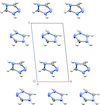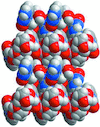issue contents
May 2021 issue

Cover illustration: α-2′-Deoxycytidine is the α-anomeric analogue of the canonical β-2′-deoxycytidine and adopts conformational parameters which lie outside the conformational range usually preferred by α-nucleosides. Crystal packing is controlled by N—H⋯O and O—H⋯O contacts between the nucleobase and sugar moieties. See Budow-Busse, Chai, Müller, Daniliuc & Seela [Acta Cryst. (2021), C77, 202–208].
research papers




 access
access













 journal menu
journal menu

























